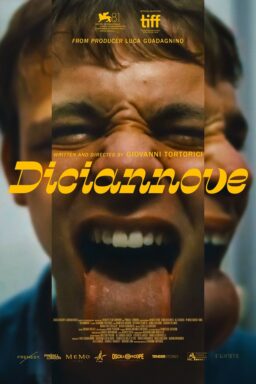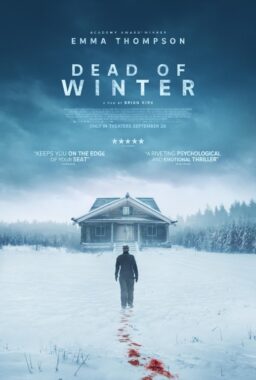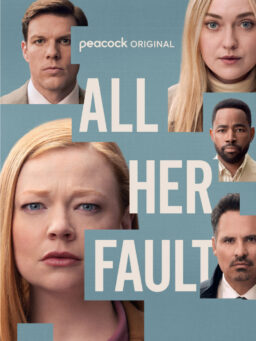

My friend the film critic Richard T. Jameson made a clever and brilliant observation about Jonathan Glazer’s “Birth,” my favorite movie of 2004, before I’d even seen it. RTJ said he thought it was as if the Surrealist masterpiece “Un Chien Andalou” had been adapted into a narrative feature film. And so it is. I’d almost forgotten about this by the time I saw the movie, but there was something about that “Ten Years Later” title at the beginning that tweaked my movie-memory… (Titles like that always make me think of “Un Chien Andalou.”) But by the time Danny Huston was pushing a piano across the room I was jumping out of my seat.
Robert C. Cumbow (former contributor to RTJ’s Movietone News, a publication of the Seattle Film Society) and Dennis Cozzalio have both written eloquently and appreciatively about “Birth,” and its Kubrickian connections in particular (and I’m working on something else in connection with the film for Scanners and RogerEbert.com — stay browsed!). But I wanted to contribute a few observations (specifically visual ones) from the Andalusian Dog perspective, because echoes of Buñuel (particularly “Un Chien Andalou” and “Belle de Jour“) reverberate throughout “Birth.”… [SPOILERS AHEAD]

“Belle de Jour”: opening shot

“Birth”: opening shot. The fluttering flutes and sleigh bells echo not only the bells in “Belle de Jour,” but the opening of Mahler’s Fourth Symphony. In fact, the whole score, with its sudden shifts in tempo, unusual orchestrations, and stormy changes in mood, is quite Mahlerian.
First, you may recall that the screenplay was co-written by Jean-Claude Carrière, Buñuel’s writing collaborator on “Diary of a Chambermaid,” “Belle de Jour,” “The Milky Way,” “The Discreet Charm of the Bourgeoisie,” “The Phantom of Liberty” and “That Obscure Object of Desire.” Indeed, if you’re looking for a primary reference point for that extraordinary opening shot/sequence in “Birth” — looooooong take of a man running along a path through a park, to the accompaniment of (among other instrumentation) rhythmically chiming sleigh bells — you need look no farther than the opening shot of “Belle de Jour.” In that 1967 film, with Catherine Deneuve in the title role, this woodsy prologue turns violent, and is revealed as a woman’s S&M fantasy about her husband. Hmmmm.

“Belle de Jour”: the reverse angle.

“Birth” reverse angle. The runner re-appears at the far left in the distance, moving perpendicular to the camera, and then toward it, following the winding path.

The “Belle de Jour” carriage, bearing the woman and her “husband,” re-appears in “Birth.”
In “Belle de Jour” the camera is stationary and the coach, bearing the woman and her husband, comes toward the camera on the diagonal (an image repeated later in “Birth”). The camera pans almost 180 degrees as they go by, and the coach continues down the trail, which appears to dead-end into a river. This is followed by a reverse angle with the camera in motion, on the trail, moving to meet the approaching coach (a combination of dolly and zoom).
In “Birth,” it’s just the opposite: An elevated Steadicam shot follows the husband (hooded, like a lone spermatozoa) along his winding path (to a literal dead-end); followed by a reverse shot that is initially stationary, and then withdraws beneath an overpass and vaginal birth/death canal.)

The Mate, in a long shot from behind, heads down the road toward home… and death, very much like the opening movement of “Birth.”

Dogs (Andalusian ones) cross Sean’s path in the opening moments of “Birth.” They appear out of nowhere (they’ve been hiding behind the pen on the right).

An illogical leap. (Terry Gilliam’s “The Adventures of Baron von Munchausen” begins with a series of comical time-and-place titles that brilliantly riff on this.)


Later (or is it earlier?) “Un Chien Andalou” makes a mockery of chronology. Time flows into itself, like an ocean.
Both films begin with a prologue that sets up their central metaphors: In “Un Chien Andalou,” Bunuel himself sees a cloud slice across the moon and then draws his straight razor across the eye of a woman, who proves to be the main character in the following film, an image that helps shock the audience into a more receptive (or disoriented) state to prepare them for the Surrealist visions to come, opening their eyes to a new way of seeing.
“Birth” opens with a relentless track toward death — and the rebirth of the husband of the movie’s main character. And he himself sets up the movie, off-camera:
OK, let me say this. Let me say this: If I lost my wife and, uh, the next day, a little bird landed on my window sill, looked me right in the eye, and in plain English said, “Sean, it’s me, Anna. I’m back.” What could I say? I guess I’d believe her. Or I’d want to. I’d be stuck with a bird. But other than that, no. I’m a man of science. I just don’t believe that mumbo-jumbo. Now, that’s gonna have to be the last question. I need to go running before I head home.
The prologues of Buñuel’s and Glazer’s films are followed by title cards indicating the passage of time:
“Un Chien Andalou”: “Eight Years Later.”
“Birth”: “Ten Years Later.”

The Woman carefully and tenderly arranges her dead Mate’s clothing on the bed before imagining him back to life.

Anna fastidiously tucks Sean (who says he is her dead husband) into bed, as if she could capture him between the covers.

“Un Chien Andalou”: The Other Woman (in trenchcoat) clutches the striped box. This one has a severed hand in it.

“Birth”: The Other Woman (in trenchoat) holds the striped box. This one contains letter’s from Anna’s dead husband Sean — and they turn out to be the medium for his resurrection.
While there’s no shot-for-shot, point-by-poing correlation between the imagery and “narratives” of the two films (“Un Chien Andalou” is defiantly non-narrative), if you look at one of them through the prism of the other (that’s what a great double-bill is for), you can see an x-ray of their spines.
Both films are about a Woman, a dead Mate (or husband) who returns (or is willed back to life by the Woman) and whose existence is contained in a striped box, from which he, or his memory, is resurrected.

The Woman imagines her Mate back to life.

Anna imagines Sean back to life at a Wagnerian opera, in one of the most extraordinary shots in “Birth.” (Parts of Wagner’s “Tristan und Isolde” overture, alternating with a tango, were used to score “Un Chien Andalou,” according to a sound version prepared by Buñuel in 1960.)
There’s also Another Woman who treasures the striped box, which is associated with death (a severed hand; Sean’s letters). A Suitor attempts to woo the Woman, but she resists.
In anger and frustration, he pulls (or pushes) a grand piano (symbol of civilization) across a room in a desperate attempt to reach her. In the end, the Mate dies, and the Woman goes off with the Suitor (in “Birth”) or another Lover (“Un Chien Andalou”).

An overhead of the Other Woman and the severed hand from “Un Chien Andalou.” The policeman holds the open striped box, into which he will put the hand and return it.

An overhead shot of Anna meeting Sean from “Birth.” Sean is in possession of the contents of the striped box.

The Suitor pulls the pianos across the room, trying to reach the Woman.

Joseph, the Suitor, pushes a piano across the room in a desperate gesture to salvage his engagement to Anna.

As he dies, the Mate’s hands flutter and caress with erotic longing over the back of the Woman…

… as Sean’s hands flutter and caress Anna’s face, as he pulls her down to kiss him.
What’s most interesting (and Bunuel would return to a variation on this theme in his final film, “That Obscure Object of Desire”) is that in both movies, there’s a confusion and conflation of identities. The Mate and the Suitor appear to be the same man in “Un Chien Andalou,” while the Mate re-appears as a 10-year-old boy (and rival Suitor) in “Birth.”
In both cases, the Mate must be killed off forever so that the Woman can go off with the Suitor/Lover. Both films end, in the Spring, on the shore, with images that evoke final acceptance of the death of the Mate (the stripped box and clothing in ruins in “Un Chien Andalou”; Anna’s breakdown in her bridal gown in “Birth.”)

This title comes after the final beach scene (and before the final image of the dead lovers, half swallowed by sand on the beach, in “Un Chien Andalou.”

This title appears just before the last scene at the beachside wedding of Anna and Joseph in “Birth.”

The Woman and her Lover embrace at the edge of the sea.

Anna and Joseph embrace at the edge of the sea.
So, what is “Birth” about? Is it really about a boy who believes he’s the reincarnation of a woman’s dead husband, or a woman who shares that same fantasy? Not so much. I think it’s pretty much about what Sean says before the first shot of the movie: Love (a brain chemical reaction as powerful as heroin) is so far beyond the rational that we can rationalize almost anything about the one we love, and we have no control over who that may be. Further, we don’t even really know the person with whom we fall in love, because the essence of another person is something elusive and indefinable (and probably largely a product of our own will and imagination). I think “Birth” is about the essential unknowability of human beings, including those who are closest to us — and even ourselves to ourselves. It’s a film about existential aloneness, and our yearning to overcome it, even though the object of our desire will always remain somewhat obscure. And that can be a real eye-opener.
Oh, and about the dog in “Un Chien Andalou” (“An Andalusian Dog”): There isn’t one.

The Lovers find the remains of the dead Mate.

The final death of Sean (the dead Mate) may happen here. Anna stoops over just as Sean did before he collapsed and died beneath the overpass.

“Birth”: Rebirth? Anna comes back from the sea, recalling the newborn baby emerging from the water in the pre-title sequence.

The lovers walk off toward an uncertain future.

The lovers walk off toward an uncertain future.

Coda: Till death do them part. The final image of the Lovers in “Un Chien Andalou.” (The final image of “Birth” is above.)

I have a feeling there’s an association between the last shot of “Un Chien Andalou” (1928) and the last shot of “College” (1927) by Buster Keaton, a big fave of the Surrealists (and the greatest filmmaker in the history of the cinema). A series of quick dissolves takes a young couple from their wedding day, to middle age, to old age, and then to this final image.










